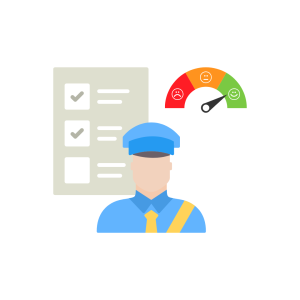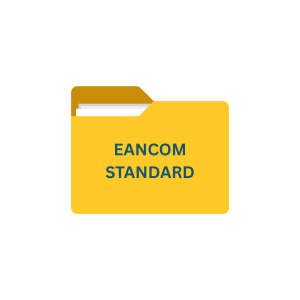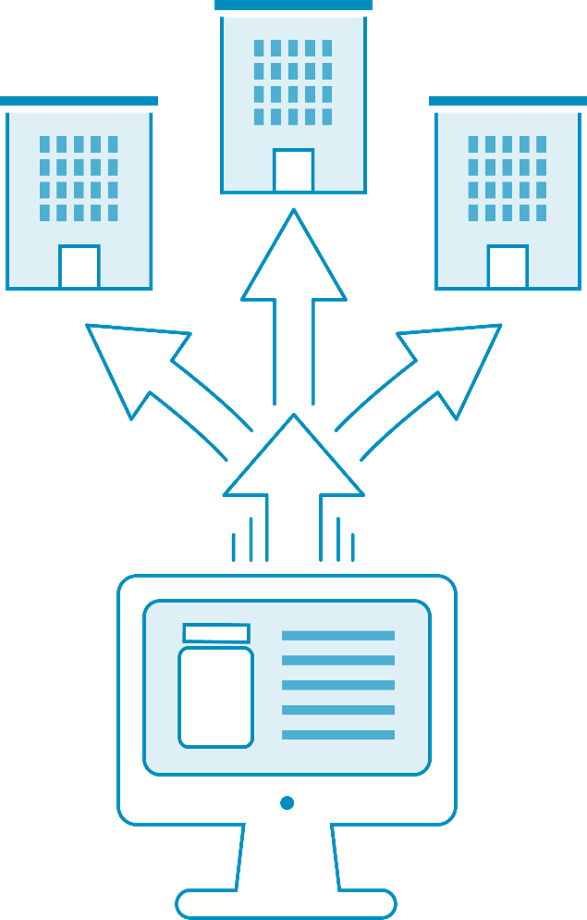
Introduction
GDSN for Healthcare Buyers and Suppliers
Small and Medium Enterprises (SMEs) operating within the healthcare sector strive to rival industry giants in innovation, flexibility, and operational efficiency. Despite their size, these SMEs must adhere to the same rigorous industry standards and regulations as their larger counterparts. GDSN plays a pivotal role in assisting SMEs to harness the power of GS1 Standards, enabling them to meet the demands of their trading partners and compete effectively with multinational corporations. Many SMEs have successfully integrated GS1 Standards into their operations, utilizing Global Trade Item Numbers (GTINs), GS1 Bar Codes, and GS1’s Global Data Synchronization Network (GDSN) for various purposes. Through these implementations, SMEs are experiencing tangible outcomes and reaping the benefits of their adherence to GS1 Standards.
Research, innovation, and product development are hallmarks in the healthcare sector, alongside robust competition. Although multinational corporations hold sway in numerous segments, Small and Medium Enterprises (SMEs) wield significant influence. Many groundbreaking innovations in healthcare stem from SMEs, necessitating swift and efficient market entry for successful competition within the industry.
Key Takeaways
- The Global Data Synchronization Network (GDSN) is transforming the healthcare industry by enabling accurate, real-time sharing of product data between manufacturers, distributors, and healthcare providers.
- GDSN ensures that all stakeholders have access to standardized, up-to-date information on medical products, improving supply chain efficiency, patient safety, and regulatory compliance.
- By leveraging GDSN, healthcare organizations can reduce errors, optimize inventory management, and enhance overall operational performance, making it an indispensable tool for modern healthcare supply chains.
The Importance of a Standardized Approach
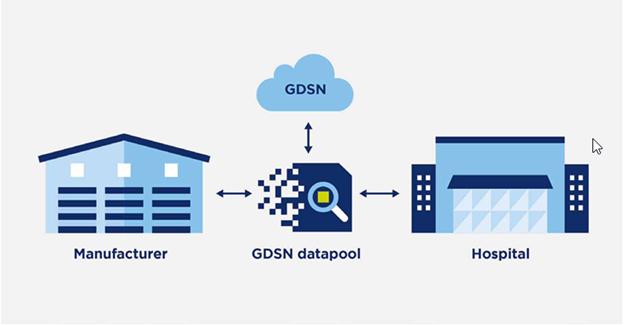
Today 95% of packages dispensed at retail pharmacies carry a GS1 GTIN in a GS1 Bar Code
The pharmaceutical and medical industries deal with intricate products subject to stringent regulations, necessitating efficient and precise identification throughout the supply chain. Moreover, comprehensive product master data exchange among suppliers, distributors, regulators, and end users is imperative. Any inaccuracies pose potentially life-threatening risks and, at minimum, result in loss of reputation and business for manufacturers and distributors.
GS1 Standards offer a versatile solution applicable across industries and business sizes. Leveraging the GS1 System, companies can uniquely identify and annotate their products with pertinent production details such as Batch or Lot Number, Serial Number, or Expiration Date. Furthermore, by adopting GS1 Standards for the Global Data Synchronization Network (GDSN), organizations can securely share their product and pricing master data with key trading partners.
Since October 2012, significant industry position statements have been issued, clearly outlining the healthcare sector’s trajectory toward embracing GS1 Standards for product identification, marking (via barcoding or radio frequency identification), and data synchronization.
One such statement, the National E-Health Transition Authority (NEHTA) Communiqué on GTIN Use Best Practice in Australian Healthcare, released in October 2012, underscores the imperative of GTIN allocation and utilization by global standards. It advocates for adopting GTIN Best Practices by Australian healthcare suppliers, urging them to refrain from re-using GTIN for Regulated Healthcare Trade Items.
How Does GDSN Help Healthcare Buyers and Suppliers?
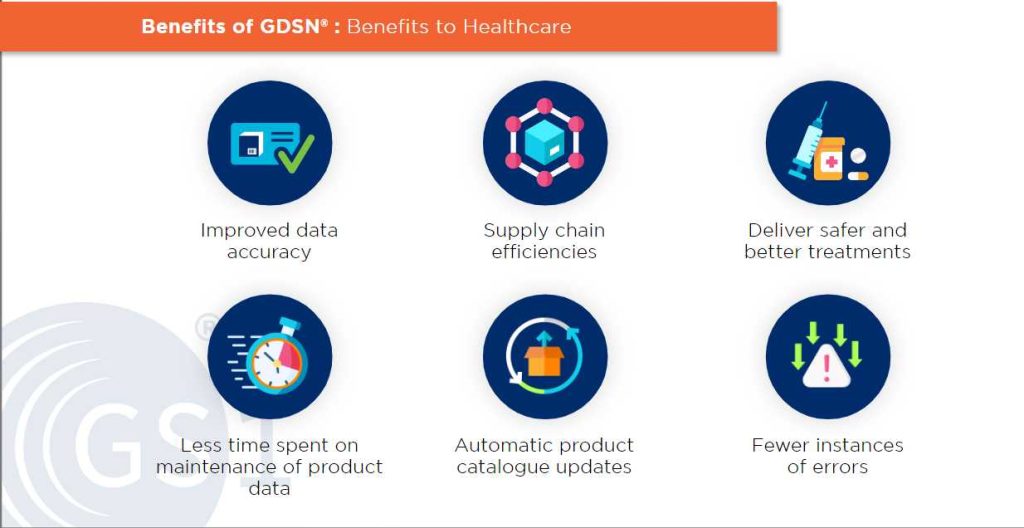
The GDSN serves as a centralized repository for product, pricing, and healthcare data across all healthcare industry categories, facilitating data synchronization. These categories encompass pharmaceuticals, medical devices (such as orthopedic prostheses, implantable devices, dental products, imaging equipment, etc.), and medical consumables. The primary goal of the GDSN is to enhance overall data integrity within the sector.
Introduced to establish the groundwork for an interoperable electronic supply chain system, the GDSN aims to deliver quality and efficiency benefits to both providers and consumers. It offers suppliers a unified platform to electronically communicate standardized and accurate product and pricing information to Australian health departments and private hospital providers.
Key Advantages of the GDSN and Data Synchronization
- Current, accurate, standardized product information
- Foundation for a nationally standardized method of electronic procurement
- Secure pricing information available only to nominated trading partners
- Ensure reliable continuity of supply with minimum inventory investment
- Removes inefficient and error-prone paper-based processes, and automates the efficient distribution of product information
- Reduce order errors and the supply costs associated with invoice reconciliations, credit claims, returns, and refused deliveries
Case Studies - Healthcare GDSN Success in Australia
Three Australian companies that benefited from GDSN and GS1 Standards are,
- Orion – A Perrigo Company
- Link Healthcare
- Care Essentials
Case Study 1 – Orion – A Perrigo Company
Orion embarked on its GS1 Standards implementation journey in 2005, initially participating as the SME representative in the Victorian Government-funded project known as ‘eCommerce in the Hospital Pharmaceutical Supply Chain’ (Monash Project). Back then, while GS1 GTINs in barcodes were prevalent in the pharmaceutical sector, they hadn’t reached the current ubiquity—where 95% of packages dispensed at retail pharmacies carry a GS1 GTIN in a GS1 Barcode. During the Monash Project, Orion discovered that 14 out of the top 15 products ordered by the Monash Medical Centre Pharmacy Department bore GS1 Barcodes at the unit level but lacked compliance at the inner or carton level. To address this, Orion redesigned adhesive labels for these packaging levels, aligning them with the Orion corporate label and adopting the GS1-128 Barcode, capable of encoding additional information such as Batch Number and Expiration Date—essential attributes for pharmaceutical traceability.
Orion implemented internal processes for barcode printing and in-process verification, alongside reviews of labeling requirements to ensure compliance with regulatory standards. The decision to expand GS1 Barcode usage was a straightforward post-project, driven by the significant supply chain efficiency benefits associated with barcode scanning—critical for transactions with Orion’s customers. The subsequent step was the adoption of the GDSN, viewed as the future of the supply chain, especially as most medium to large companies were already utilizing it. To participate in health department and private hospital tenders, Orion needed to populate the GDSN with all product information, a process simplified by the implementation program provided by GS1 Australia. However, collating information from diverse sources into the catalog posed a challenge, necessitating the engagement of a third-party company certified by GS1.
The GDSN upload process prompted Orion to review and enhance its internal systems and processes, initially undertaking manual data uploads due to decentralized data storage. To streamline data management, Orion is transitioning all data into SAP and utilizing a third-party program provided by Bizcaps Software, a GS1net Certified Product Partner, for data upload. A key learning from this implementation was the importance of centralizing and maintaining all data in one database, supported by robust business processes for data capture and updates. While populating the GDSN is the immediate goal, having accurate data centralized benefits the organization in the long term. The forthcoming phase involves implementing GS1 Standards and barcode scanning across all Orion warehouses, leveraging barcode information to drive efficiencies and minimize errors associated with manual checks.
Case Study 2 – Link Healthcare
Link Healthcare, an Australian-based specialist Pharmaceutical and Medical Technology firm, operates with a mission to excel in marketing vital and distinctive specialist products, ultimately enhancing the wellbeing of numerous individuals in the region. Initially, Link Healthcare joined GS1net due to requirements in various state-based tenders mandating GS1 Australia membership and the upload of tendered products. However, upon involvement with the GDSN, Link Healthcare discovered additional benefits, such as simplifying customer ordering and ensuring data consistency between GDSN and internal systems.
Given that Link Healthcare’s product information and pricing change infrequently, database maintenance primarily involves adding new products or establishing pricing relationships with new customers or partners. This responsibility is centralized, and typically managed by an individual accountable for inputting new data post-approval by brand or business managers. While Link Healthcare is in the nascent stages of GDSN utilization, each new data entry becomes increasingly efficient, with users able to duplicate records and swiftly modify necessary information.
Although one central person may handle data upload, multiple individuals within the company must comprehend the system and help when needed. Looking ahead, Link Healthcare plans to data-map GDSN information to complement its accounting and ordering systems, streamlining the process from order placement to dispatch and payment. This initiative aims to mitigate sales and payment delays, ensuring accurate pricing for diverse customer segments, particularly when managing a large customer base with varying pricing tiers.
Case Study 3 – Care Essentials
Care Essentials has specialized inpatient warming since its establishment in 1996 and has set a benchmark for excellence. The development of the Care Essentials Micro Pore system for the delivery of air gives a constant airflow, thereby giving a uniform distribution of warm air across the patient. Care Essentials named its products Cocoons, as when they are used they give a warm, cocooning effect for the patient.
In 2011, Care Essentials responded to a tender by Health Purchasing Victoria, where GS1 compliance and GDSN readiness were prerequisites. Since then, being GS1 compliant has proven advantageous for securing tenders and purchasing contracts. While initially requiring significant research and data collection, GS1 Australia provided invaluable support through dedicated account managers, streamlining the process for Care Essentials.
With a modest product range and infrequent changes, compiling data for GS1 Browser Templates and loading the GDSN has proven worthwhile, especially considering the preference for GDSN-compliant suppliers in most tenders. Recently, Care Essentials submitted a tender to Northern Territory Health, where GDSN data was mandatory, further demonstrating the growing demand for GDSN compliance nationwide.
Having invested in GDSN data integration, Care Essentials now explores additional applications for this data, leveraging GS1 Standards to differentiate itself from competitors. Whether through GS1 GTIN-encoded barcodes or further GDSN promotion, Care Essentials remains committed to innovation and excellence.
Commport GDSN for Healthcare Buyers and Suppliers
Download: GDSN Buyers Guide
Empower your business with global data synchronization; download our GDSN Buyer's Guide today and take the first step towards streamlined, accurate, and compliant product data management.
Frequently Asked Questions
The Global Data Synchronization Network (GDSN) is a network of interconnected data pools that enable the secure and continuous exchange of standardized product information between trading partners. For healthcare suppliers, GDSN facilitates the accurate and timely sharing of product data such as descriptions, prices, and regulatory information, ensuring that all parties in the supply chain have consistent and up-to-date information.
GDSN improves data accuracy by ensuring that all product information is standardized and synchronized across all trading partners. This reduces errors associated with manual data entry, minimizes discrepancies in product information, and helps maintain a single source of truth for all product data, which is critical for regulatory compliance and operational efficiency.
By using GDSN, small and medium healthcare suppliers can significantly reduce the costs associated with data management, such as manual data entry, corrections, and updates. It also minimizes the expenses related to errors and discrepancies in product information. Moreover, streamlined data synchronization can lead to more efficient inventory management and supply chain operations, further reducing costs.
GDSN helps healthcare suppliers maintain compliance with regulatory requirements by ensuring that all product information is accurate, up-to-date, and consistently shared across the supply chain. This is particularly important for healthcare products, which are subject to strict regulations and standards. GDSN’s standardized data formats and synchronization capabilities help suppliers meet these regulatory demands more effectively.
GDSN enhances supply chain efficiency by enabling real-time data synchronization, reducing the time and effort needed to manage and update product information. This leads to quicker and more reliable product listings, faster order processing, and improved inventory management. By streamlining these processes, small and medium healthcare suppliers can respond more swiftly to market demands and improve their overall supply chain performance.


